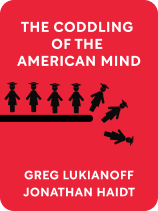

This article is an excerpt from the Shortform book guide to "The Coddling of the American Mind" by Greg Lukianoff and Jonathan Haidt. Shortform has the world's best summaries and analyses of books you should be reading.
Like this article? Sign up for a free trial here .
Why is instilling antifragility in children so important? How can you raise your kids to be more independent, rational, and moral?
In The Coddling of the American Mind, authors Jonathan Haidt and Greg Lukianoff give parenting advice for the modern-day. They believe that kids today aren’t given enough independence and that they need to overcome obstacles in order to become stronger.
Keep reading to learn how to instill antifragility and independence in your children.
Antifragile Kids
Earlier in this summary, we introduced the concept of antifragility—that kids do not suffer from experiencing mild adversity; on the contrary, it makes them stronger. Overcoming difficulty is an essential part of the passage from childhood to adulthood. This is why the excessive focus on safety and efforts by parents to minimize risk, however well-intentioned, actually do great emotional harm to young people.
Because they are deprived of the opportunity to make mistakes, kids do not learn how to properly evaluate risks, gain independence, and navigate interpersonal conflicts without relying on a third-party authority figure, like a parent (or, later in life, a university official).
Prepare for Independence
Parents should give their children more opportunities to exercise their independence, even starting at an early age. This can be as simple as allowing them to enjoy more free and unsupervised play. When they notice conflicts arising among children during play, they should resist the temptation to intervene or make them “play fair.”
Parents would also be wise to periodically ask their independent children what new challenges they want to take on. Even small milestones like walking to school or friends’ houses on their own can be remarkably self-affirming for kids. This also teaches them that “stranger danger” is an overhyped myth and that, if trouble arises, they should ask strangers for help.
Parents should pause, take a breath, and remember that the risk of abduction at the hands of strangers is practically zero and that crime, in general, is far lower than when they were children.
Break Emotional Reasoning
Parents also would do well to teach their kids not to rely on their emotions as their sole guide for interpreting reality. Even teaching children the basic principles behind cognitive behavioral therapy (CBT) can be beneficial.
To recap, CBT teaches people to break the vicious cycle of negative thinking by identifying and labeling untrue negative thoughts in order to foster more positive and realistic views of themselves. Parents can model this behavior by identifying and labeling their own negative thoughts to their children and showing them they’re irrational.
Parents can then use this as a launching pad for deeper discussions about the relationships between feelings and reality. For example, children often have a remarkable ability to understand difficult ideas through the use of metaphors and allegories. A parent might explain that reality can exist independently of one’s feelings by pointing out that even if someone feels that it’s snowing outside, they might be incorrect—it either is or isn’t snowing. One has to appreciate facts as well as feelings.
Embrace Nuance
Lastly, parents should impress upon their children that no one is purely good or evil. All of us are complex beings with the capacity to do both good things and bad things based upon our circumstances and our state of knowledge at a given time.
Black-and-white moral thinking can be highly damaging to a child’s emotional development. Even when children are wrong, parents should listen respectfully to their opinions and try to use reason to guide them toward more correct and accurate patterns of thought. This will teach a child that she is not a bad or immoral person simply because she is wrong about something or is in disagreement with someone.
This, in turn, will teach her to apply this logic to others—that they are not bad simply for having different opinions. She will gain humility (because they will know that they, too, are capable of being wrong) and learn to give others the benefit of the doubt, instead of assuming the worst.
Encourage Antifragility in the Schools
Outside of the home, parents should encourage elementary, middle, and high schools to adopt policies that boost antifragility.
Teachers should stop assigning heavy workloads of homework, especially for younger children. They should instead be encouraged to use the time spent on homework on free play and exploration, where they can learn healthy interpersonal and independence skills from their peers.
Schools should also put greater emphasis on recess, with less adult supervision. While kids should always be kept safe, the definition of “safety” should be narrowed to mean only physical safety. Even if some kids are being excluded or groups of kids aren’t playing “fair,” these are opportunities for kids to explore how to handle rejection and emotional discomfort on their own—which will build their long-term emotional fortitude.
School administrators should also strictly limit the use of devices on school property, as they have been shown to disrupt the learning process and (especially social-media apps) increase feelings of social isolation, which leads to anxiety and depression. As kids get older, educational institutions should be mindful of the fact that today’s youth grow up much slower than previous generations.
Even if they are able to master college-level coursework, students often arrive on campus unprepared for the social and emotional responsibilities of independent living. This is why there is a growing push to delay the admission of high school graduates into college.
Public figures like retired United States Army General Stanley McChrystal propose a “gap year” between high school and college, during which young adults can live and work away from their parents. This will teach them valuable independence and interpersonal skills, hopefully reducing their demands for safety and protection once they do enter college.
A national gap year program would have the added benefit of bringing together young people from diverse backgrounds, better preparing them for the diversity of opinions and experiences they will encounter, both in college and in the professional world after graduation.

———End of Preview———
Like what you just read? Read the rest of the world's best book summary and analysis of Greg Lukianoff and Jonathan Haidt's "The Coddling of the American Mind" at Shortform .
Here's what you'll find in our full The Coddling of the American Mind summary :
- The "three Untruths" that have taken hold of young people
- The damage that "speech codes" cause on college campuses
- How colleges are increasingly seeing students as customers






